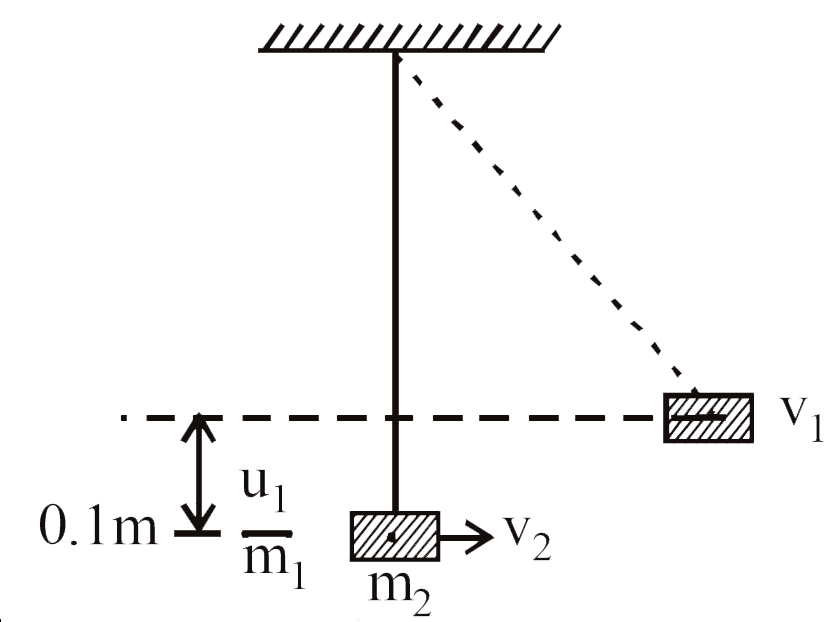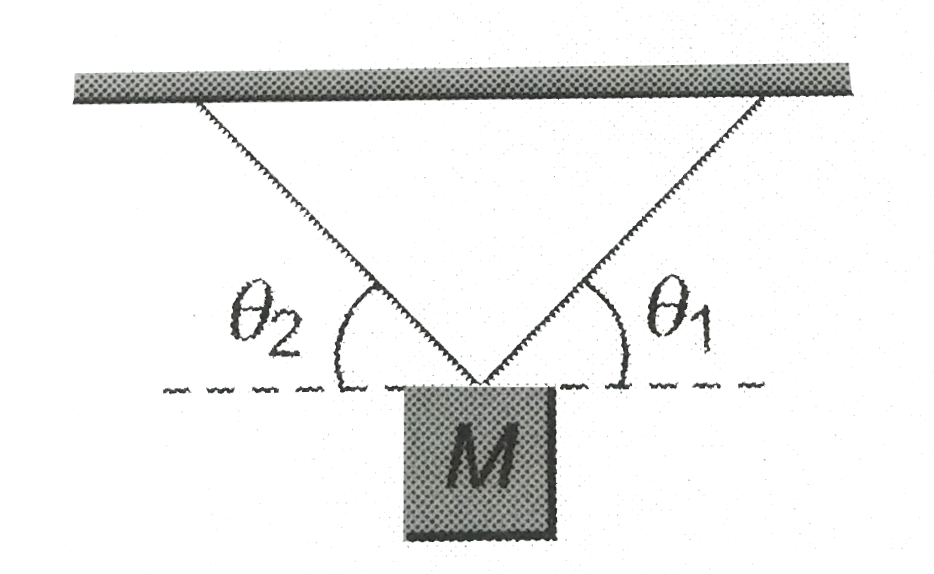A bullet of mass 20 kg travelling horizontally at 100ms−1 gets embedded at the centre of a block of wood of mass 1kg, suspended by a light vertical string of 1m in length. Calculate the maximum inclination of the string to the vertical.
The correct Answer is:37∘
To solve the problem, we will follow these steps:
Step 1: Understand the Problem
We have a bullet of mass m=20g=0.02kg traveling horizontally at a speed of v=100m/s that embeds itself into a block of wood of mass M=1kg. The block is suspended by a string of length L=1m. We need to find the maximum angle θ that the string makes with the vertical after the bullet embeds into the block.
Step 2: Apply Conservation of Momentum
Since there are no external horizontal forces acting on the system, we can use the conservation of momentum. The initial momentum of the bullet before it hits the block is equal to the momentum of the bullet-block system after the collision.
Initial momentum=Final momentum
m⋅v=(M+m)⋅V
Where V is the velocity of the combined mass after the collision.
Substituting the values:
0.02⋅100=(1+0.02)⋅V
2=1.02⋅V
V=21.02≈1.96m/s
Step 3: Calculate the Kinetic Energy
The kinetic energy of the bullet-block system just after the collision is given by:
KE=12(M+m)V2
Substituting the values:
KE=12⋅1.02⋅(1.96)2
Calculating (1.96)2:
(1.96)2≈3.8416
Thus,
KE≈12⋅1.02⋅3.8416≈1.96J
Step 4: Convert Kinetic Energy to Potential Energy
As the block swings up, the kinetic energy will convert into potential energy at the maximum height h:
PE=(M+m)gh
Setting KE=PE:
1.96=(1.02)⋅9.81⋅h
Solving for h:
h=1.961.02⋅9.81≈1.9610≈0.196m
Step 5: Determine the Maximum Inclination Angle
The height h is the vertical rise of the block. The length of the string is L=1m. The horizontal distance x from the lowest point to the point where the string makes an angle θ with the vertical can be found using the Pythagorean theorem:
L2=h2+x2
Substituting h=0.196:
12=(0.196)2+x2
Calculating (0.196)2:
(0.196)2≈0.038416
Thus,
1=0.038416+x2
x2=1−0.038416≈0.961584
x≈√0.961584≈0.98m
Step 6: Calculate the Angle θ
Using the cosine of the angle:
cosθ=adjacenthypotenuse=0.81
Where 0.8=L−h=1−0.196.
Thus,
cosθ=0.8
θ=cos−1(0.8)≈36.87∘≈37∘
Final Answer
The maximum inclination of the string to the vertical is approximately θ≈37∘.
---
We have a bullet of mass m=20g=0.02kg traveling horizontally at a speed of v=100m/s that embeds itself into a block of wood of mass M=1kg. The block is suspended by a string of length L=1m. We need to find the maximum angle θ that the string makes with the vertical after the bullet embeds into the block.
Since there are no external horizontal forces acting on the system, we can use the conservation of momentum. The initial momentum of the bullet before it hits the block is equal to the momentum of the bullet-block system after the collision.
m⋅v=(M+m)⋅V
Where V is the velocity of the combined mass after the collision.
0.02⋅100=(1+0.02)⋅V
2=1.02⋅V
V=21.02≈1.96m/s
The kinetic energy of the bullet-block system just after the collision is given by:
KE=12(M+m)V2
Substituting the values:
KE=12⋅1.02⋅(1.96)2
Calculating (1.96)2:
(1.96)2≈3.8416
Thus,
KE≈12⋅1.02⋅3.8416≈1.96J
As the block swings up, the kinetic energy will convert into potential energy at the maximum height h:
PE=(M+m)gh
Setting KE=PE:
1.96=(1.02)⋅9.81⋅h
Solving for h:
h=1.961.02⋅9.81≈1.9610≈0.196m
The height h is the vertical rise of the block. The length of the string is L=1m. The horizontal distance x from the lowest point to the point where the string makes an angle θ with the vertical can be found using the Pythagorean theorem:
L2=h2+x2
Substituting h=0.196:
12=(0.196)2+x2
Calculating (0.196)2:
(0.196)2≈0.038416
Thus,
1=0.038416+x2
x2=1−0.038416≈0.961584
x≈√0.961584≈0.98m
Using the cosine of the angle:
cosθ=adjacenthypotenuse=0.81
Where 0.8=L−h=1−0.196.
cosθ=0.8
θ=cos−1(0.8)≈36.87∘≈37∘
The maximum inclination of the string to the vertical is approximately θ≈37∘.
Topper's Solved these Questions
- FRICTION, WORK POWER AND ENERGYBOOK - NN GHOSHCHAPTER - FRICTION, WORK POWER AND ENERGYEXERCISE - Exercises (B)
36 Videos
- FRICTION, WORK POWER AND ENERGYBOOK - NN GHOSHCHAPTER - FRICTION, WORK POWER AND ENERGYEXERCISE - Exercises (B)
36 Videos
- FIRST LAW OF THERMODYNAMICSBOOK - NN GHOSHCHAPTER - FIRST LAW OF THERMODYNAMICSEXERCISE - All Questions
39 Videos
- GRAVITATIONBOOK - NN GHOSHCHAPTER - GRAVITATIONEXERCISE - EXERCISE
29 Videos
Similar Questions
A bullet of mass 10g travels horizontally with speed 100m/s and is absorbed by a wooden block of mass 900 g suspended by a string. Find the vertical height through which the block rises. Given g=10m/s2
View SolutionA bullet of mass 0.01 kg travelling at a speed of 500 m/s strikes a block of mass 2 kg, which is suspended by a string of length 5 m. The centre of gravity of the block is found to rise a vertical distance of 0.1 m. The speed of the bullet after it emerges from the block will be -

View Solution
Knowledge Check
A bullet of mass 10 g moving horizontally with a velocity of 400ms−1 strikes a wook block of mass 2 kg which is suspended by light inextensible string of length 5 m. As a result, the centre of gravity of the block found to rise a vertical distance of 10 cm. The speed of the bullet after it emerges out horizontally from the block will be
A100ms−1B80ms−1C120ms−1D160ms−1A bullet of mass 10 g moving horizontally with a velocity of 400ms−1 strikes a wooden block of mass 2kg which is suspended by a light inextensible string of length 5 m. As a result, the centre of gravity of the block is found to rise a vertical distance of 10 cm. The speed of the bullet after it emerges out horizontally from the block will be
A100ms−1B80ms−1C120ms−1D160ms−1A bullet of mass 10g moving horizontally with a velocity of 400ms−1 strikes a wooden block of mass 2kg which is suspended by a light in-extensible string of length 5m. As a result, the center of gravity of the block is found to rise a vertical distance of 10cm . The speed of the bullet after it emerges out horizontally from the block will be
A120ms−1B160ms−1C100ms−1D80ms−1
A block of mass M si suspended by two strings angles θ1 and θ2 with the horizontal. Find the tensions in the strings.

View SolutionA body of mass 5 kg is whirled in a vertical circle by a string 1 m long. Calculate velocity at top of the circle for just looping the vertical loop.
View SolutionA bullet of mass 10 g moving horizontally with a velocity of 400ms−1 strikes a wooden block of mass 2kg which is suspended by a light inextensible string of length 5 m. As a result, the centre of gravity of the block is found to rise a vertical distance of 10 cm. The speed of the bullet after it emerges out horizontally from the block will be
View SolutionA bullet of mass 0.01kg and travelling at a speed of 500ms−1 strikes a block of mass 2kg which is suspended by a string of length 5m. The centre of gravity of the block is found to raise a vertical distance of 0.2m. What is the speed of the bullet after it emerges from the block?
View SolutionA bullet of mass 20g moving horizontally strikes a block of mass 480g suspended by a string of length 2m. If the collision is completely inelastic , the minimum velocity of bullet , so that the combined mass complete vertical circle should be
View Solution
